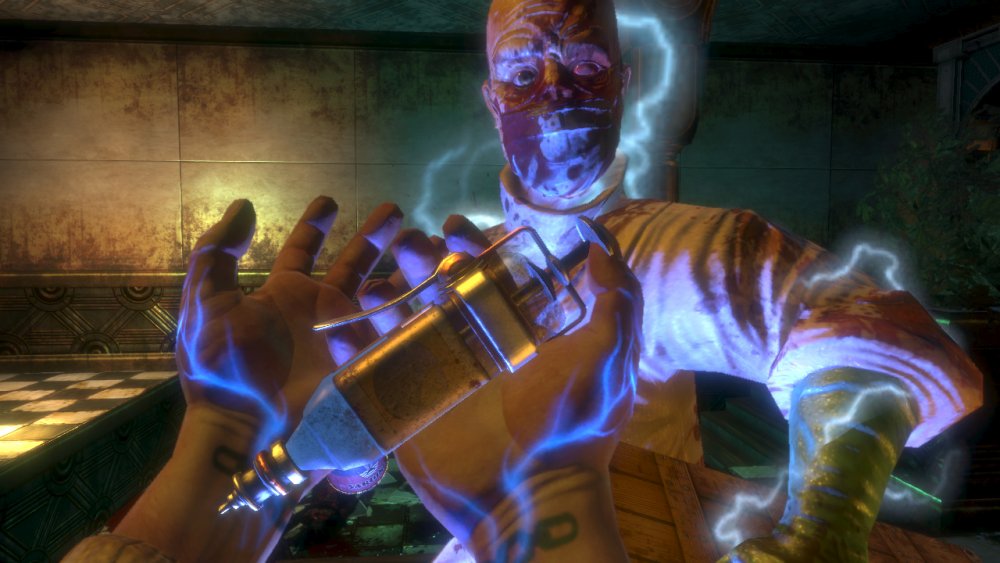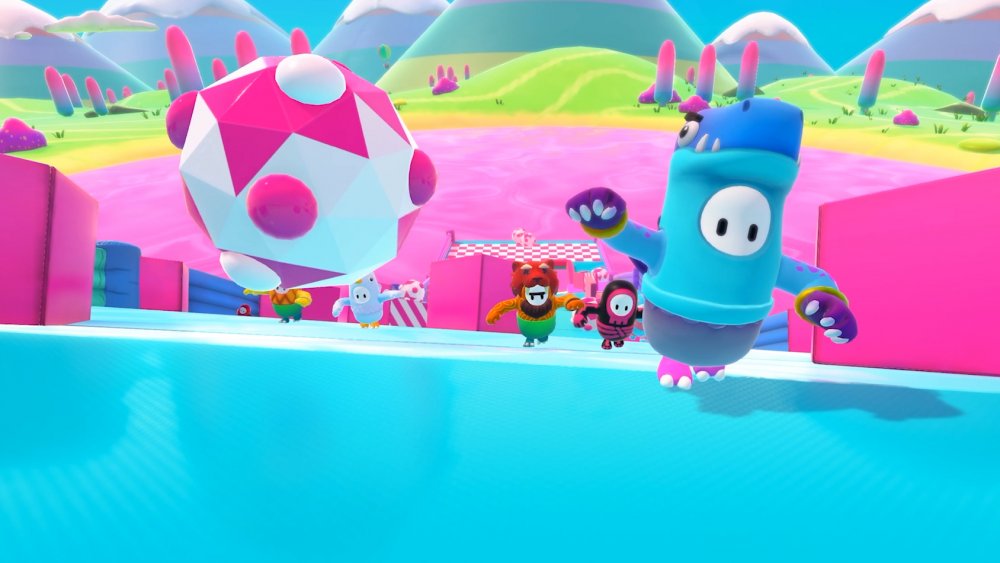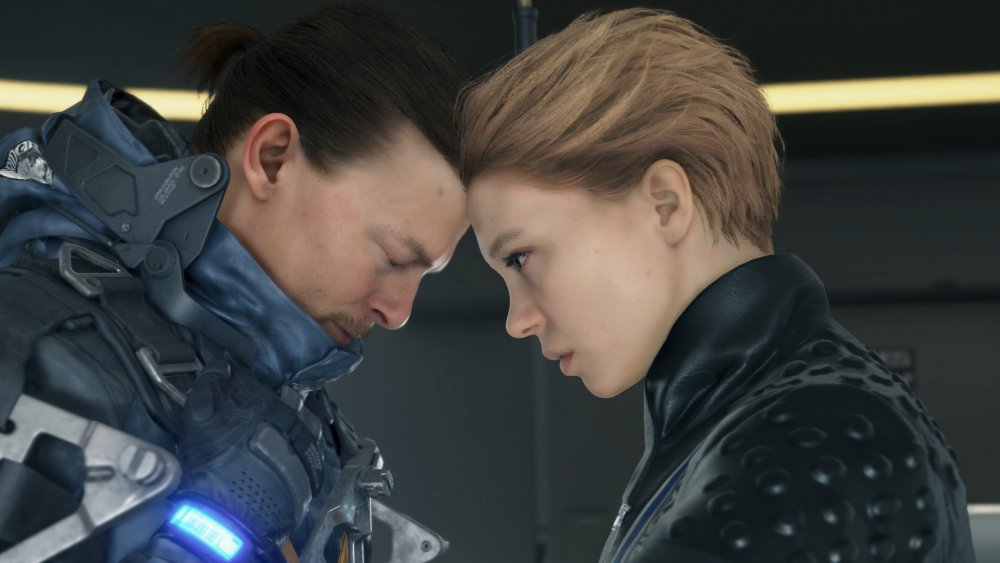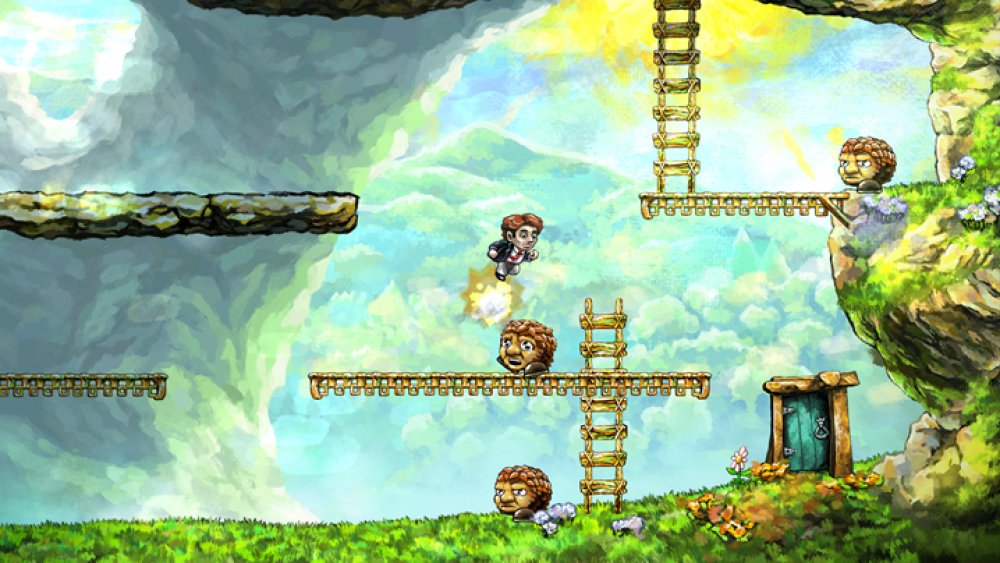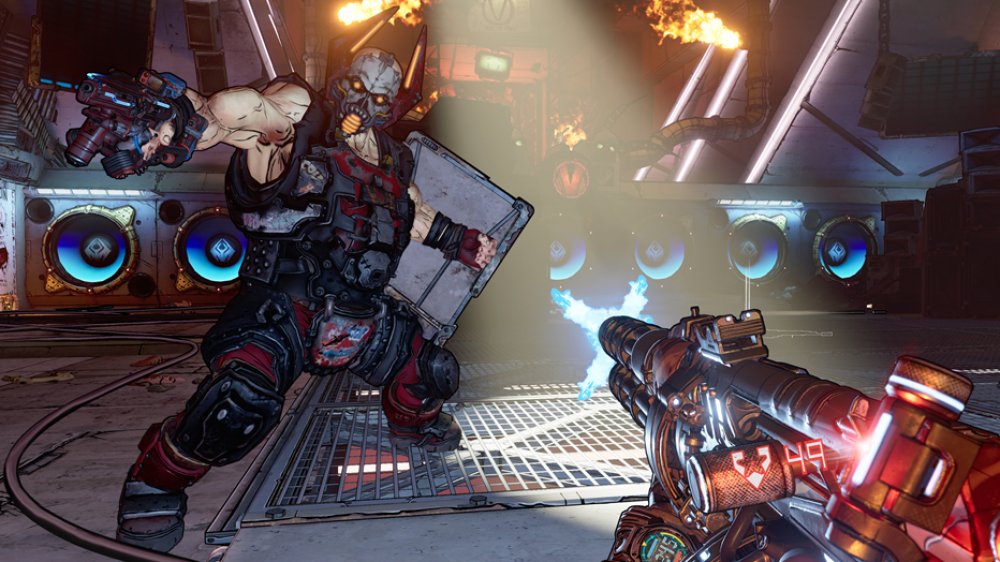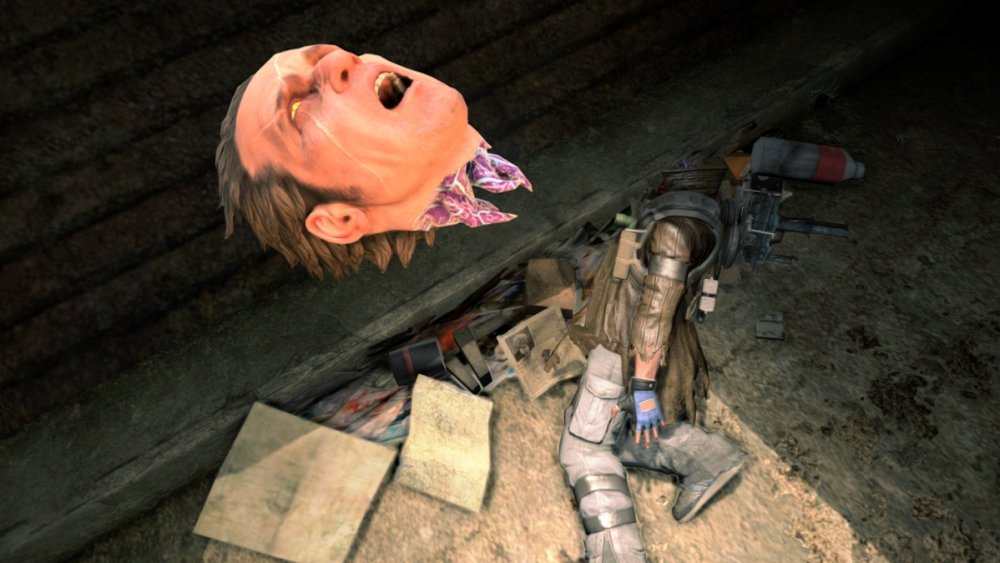Game Characters That Never Actually Die
The iconic "GAME OVER" screen has graced many a home television and arcade cabinet over the decades. Its message is clear: You — the player — have done goofed, and you've paid for it with your pixelated counterpart's life. Maybe you fell prey to zombie mutts in Resident Evil and received that dreaded "YOU DIED" message. Maybe you jumped out of that cardboard box one second too early, only to be met with a hail of bullets as the desperate voices of Snake's companions call out his name over the Codec in Metal Gear Solid. Whatever puts your favorite video game character down, one thing is hard to ignore: In video games, death is unforgiving — most of the time.
When it comes to video games, there's no hard and fast rule that says developers have to make their Game Over screen the end of the game. Heck, there's no rule that a game needs a Game Over screen, period. And without a Game Over screen, the line between the life and death of your character gets a little fuzzy. With that in mind, these are some of gaming's most death-proof protagonists.
WASTE not, want not (GTA Protagonists)
Criminal power fantasy. Open-world sandbox. Biting social commentary. Grand Theft Auto offers a whole lot of things, but realism is not one of them. It's the reason why you can stumble upon an alien frozen in a lake, why Trevor faces zero legal repercussions for stomping a man to death, and why you can fit an entire gun shop's worth of artillery on your person at any given time. It's also the reason that tumbling violently down from the highest peak of Mt. Chiliad is a minor inconvenience rather than the human equivalent of dropping a tomato from a second story balcony.
While the word "WASTED" might sound pretty brutal, "dying" in GTA is nothing that a trip to the hospital and an affordable medical bill can't fix. But it's not just the anti-hero who can walk away from a bonkers brawl without a scratch. The mortality rate in the GTA series is probably lower than you think. While a bag of burning dog doo-doo would offer better healthcare than GTA 5's paramedics, EMTs in earlier 3D entries like GTA 3 and GTA 4 actually attempt to resuscitate pummeled pedestrians — and they often succeed. Hey — a properly functioning healthcare system isn't exactly immortality, but it's something!
Veni, vidi, Vita-Chamber (Jack in BioShock)
For all its grounded socio-philosophical musings and immersive psychological horrors, 2007's atmospheric first-person shooter BioShock sure went overboard with its science. In fact, the use of Plasmids — genetic material-altering serums that give you superpowers and just so happen to look an awful lot like high-fantasy potions — brings to mind magic rather than science. This recalls the writings of sci-fi author Arthur C. Clarke, who famously wrote: "Any sufficiently advanced technology is indistinguishable from magic." Maybe that's why players everywhere were so quick to accept the concept of Vita-Chambers, BioShock's answer to the question, "Who needs an explanation when you can throw around expressions like, 'quantum field entanglement?'"
Basically, people mauled by the malicious mutated freaks populating the fallen metropolis of Rapture are instantly resurrected, or resuscitated — or maybe even cloned? — inside one of the city's many Vita-Chambers. Hey, the science is finicky. But regardless of how Vita-Chambers work, they protect protagonist Jack from shuffling off this mortal coil — at least while he's under the sea, playing drill-catch with Big Daddies and shooting freaking bees from his hands. For the vast majority of the game's narrative, he's virtually immortal.
I get knocked down, but I get up again (Fall Guys)
When Fall Guys: Ultimate Knockout was released in August 2020, it quickly became a battle royale phenomenon. Players worldwide became obsessed with the chaotic, mini-game-based action as they guided their (freakishly tall) blobby jelly bean dudes — the titular Fall Guys — through colorful obstacle courses. But throughout all of the lighthearted yet rage-filled game-show-inside-of-a-video-game goodness, one question has loomed on the minds of gamers aplenty: What happens to the Fall Guys who, well... fall?
They don't bite the big doughnut in the sky, if that's what you're thinking. In an interview with The Gamer, lead game designer Joe Walsh explained that the Fall Guys will functionally live — and compete — forever. Walsh told the outlet that falling results in, "A moment of displacement, serenity, zen-like detachment from all worldly and physical bonds... Then they pop back onto the podium to celebrate their achievements!" He added that the Fall Guy that respawns is the same dude — not a duplicate or clone — and that it's important to show your respect for the big ol' bean.
"You've put that Fall Guy through a lot, you know. Make sure you thank them by buying them a new outfit once in a while."
Death is only the beginning (Sam in Death Stranding)
From the Metal Gear Solid 5 reveal fake-out to the P.T. puzzles that took an entire global community of players to crack, Japanese game auteur Hideo Kojima likes to play with some big, outrageous concepts. And while the reveal of his first post-Konami-breakup title, Death Stranding, was shrouded in typical, Kojima-esque mystery, it ended up leaving quite a few questions unanswered — even hours into the game. One of those questions concerned main protagonist Sam (played by The Walking Dead's Norman Reedus), and it was: How did he survive that big Voidout that killed Igor and destroyed Central Knot City in the prologue?
The answer is either super simple or devastatingly complicated, depending on your grasp of Kojima-ish concepts. In the world of Death Stranding, certain individuals suffer from a condition called DOOMS, which allows them to have a strong connection with the world of the dead — and which basically gives them superpowers. Sam — a DOOMS sufferer — just happens to have a pretty nifty ability. As a "Repatriate," he's able to enter The Seam, a Limbo-like state between life and death, and thereby return to the world of the living as his Ka (soul) returns to his Ha (body).
Whatever you say, Kojima-san.
When there's no more room in Lavender Town (Pokemon)
It's hard to remember a time when Pokemon wasn't a ubiquitous facet of global pop culture. From countless video games to a long-running TV show and everything in between, the Pokemon franchise is beloved by millions, and its popularity doesn't seem to be waning anytime soon. It seems, in a word, unkillable — much like the cutesy critters that populate its many media incarnations.
In the Pokemon games, getting pulverized in battle doesn't result in a trip to the Poke-morgue. Upon losing a melee to a fellow trainer — or encountering a particularly feisty Poke in the wild — your cuddly companion will merely faint, remaining that way until they are revived or brought to a Pokemon Center.
Sure, the anime has played with the idea of a Pokemon's mortality before — but as long as you're playing a Pokemon game, there's no need to fret about your Pocket Monster becoming worm food. Come to think of it, this whole situation probably has something to do with the fact that Pokemon is obviously for kids. Be thankful you'll never have to comfort a child who's lost a Pokemon. It sure beats trying to explain where little Johnny's goldfish went.
If I could turn back time (Tim in Braid)
Indie darling Braid isn't your grandpappy's platformer. While the 2008 title shares quite a bit in common with earlier predecessors of the genre — bopping enemies on the noggin' to knock 'em down, collecting separate pieces of a puzzle to progress — it subverts players' expectations, both narratively and mechanically, in big ways. How exactly? The twist ending reveals that the hero isn't exactly a hero. The game as a whole just might be an allusion to Oppenheimer's regret over his contributions to the development of the atomic bomb. And, to top it all off, Braid's main mechanic — the ability to freeze time and rewind in order to traverse levels and solve puzzles — gives playable character Tim control over life and death.
Time manipulation can be triggered on the fly — and when Tim finds himself in immediate danger, players are prompted to simply rewind gameplay indefinitely. At this point, players are immediately flung backwards in time to course-correct their mishap. It's a pretty convenient game mechanic that allows you to retrace your steps and learn from your mistakes. It also more or less renders good ol' Tim a god.
"Permanent death? Schmermanent schmeth" (Your character in Borderlands)
While some games, like Hideo Kojima's Death Stranding, steep their characters' invincibility in complex lore and nonsensical acronyms, others don't really expect you to ask too many questions. Sure, the scientific basis behind BioShock's Vita-Chambers is... less than sturdy. But throw quantum entanglement at something, and you can usually make it stick on a narrative level. The same cannot exactly be said for the Borderlands games and their aptly named New-U Stations.
Developed and distributed by weapons manufacturer/industrial superpower Hyperion, New-U Stations — which act as respawn points — are scattered around the Borderlands universe. They work as follows: Fall prey to one of the many dangers populating Pandora? Simply cough up a fee equal to 7% of the cashola in your character's inventory, and voila! Your character is reconstructed. Err... resurrected? Cloned?! Again: Don't worry about the science. Worry about getting back into the action (and probably dying, like, sixty more times).
Locations and functions of these nifty doo-hickies vary in Borderlands' sequels, but one thing remains the same: They represent the thin barrier between your butt and a world that will stop at nothing to kick it.
Friends in high places (The Prince in Prince of Persia)
The year 2003 brought Prince of Persia: Sands of Time, which was beloved by fans and well received by critics. It'd go on to spawn two direct sequels, but in between those sequels appeared a "reimagining" of sorts. The game was simply titled Prince of Persia. The Prince was not an actual prince. The name Farah no longer belonged to his love interest — instead, it belonged to his donkey. As you can see, this was a very different take on the series.
For better or for worse, 2008's Prince of Persia switched up quite a bit of what made its predecessors such popular platformers. And while some fans weren't too keen on these changes, others praised the game's art direction, fluidity, and the Prince's new companion: a headstrong, magical woman named Elika who just so happened to boast the ability to rescue the Prince from each and every danger that might befall him. She more or less acts as the Prince's guardians angel, teleporting around, pulling him to safety, and putting distance between him and his enemies at all times.
Going out on a limb (Bryce in NeverDead)
This one's making an appearance on a technicality. Yes, you can actually die in NeverDead. No, your character is not technically impervious to death, as his head can be dissolved by certain creepy crawlies, which will end the game. That said, come on — it's in the game's title, for crying out loud!
A once-honorable demon slayer, Bryce Boltzmann was cursed with immortality following an ill-fated meeting with the demon Astaroth 500 years prior to the main events of NeverDead. During the confrontation, Boltzmann's wife and medium (a magic user who can cast spells to support a hunter) Cypher was killed — but it gets worse. Boltzmann himself was implanted with an "evil eye" by Astaroth, who transformed the hunter into a demon and doomed him to "an eternity of remorse [and] self-hatred."
Half a millennium later, the now-bitter Bryce joins NADA — or National Anti Demon Agency — in order to pick up where he left off all those years ago. The fact that he can now collect his fallen limbs to regenerate quickly and roll around as a disembodied head until the rest of his person reassembles sure comes in handy.
Git gud or die trying (Your character in the Souls games)
The term "Soulsborne" — a catch-all term for From Software's Souls and Bloodborne titles — has become a genre unto itself. Heavy on punishing difficulties, non-linear exploration, and environmental storytelling, these titles aren't afraid to push players to their limits. While you're sure to find yourself staring at that ominous "YOU DIED" screen time and time again, your character doesn't stay dead for very long. The Soulsborne games are deliberately designed with your character's immortality in mind. In fact, their propensity for returning from the dead is built into each title's lore.
Each of the Souls games present your playable character as some variation of an immortal (and/or undead) being tasked with purging some of the most creative enemies in all of gaming from their respective realm. This tradition started in 2009's (frustratingly punctuated) Demon's Souls, in which the soul of the protagonist — "The Slayer of Demons" — is bound to the Nexus (an otherworldly hub area) by the Maiden in Black. In ensuing entries, your hero boasts different names depending on their role, from "Chosen Undead" (Dark Souls) to "Bearer of the Curse" (Dark Souls 2) and, finally, "The Ashen One" (Dark Souls 3).
Happy hunting! (The Hunter in Bloodborne)
Another entry in the so-called "Soulsborne" subgenre, 2015's Bloodborne, takes the formula established by its predecessors and mixes things up a bit. Gone is the ability to block incoming attacks. Instead, the game encourages you to evade the nasties with a well-timed dodge — though you can also shoot them in order to stagger the baddies, pre-assault. Where Dark Souls played host to crumbling medieval castles, Bloodborne's Yharnam is a decrepit Gothic city. And yet, despite all of these departures from its spiritual predecessors, one mechanic remains the same. In Bloodborne, your character — The Hunter — is prone to constant death and resurrection.
Think of Bloodborne as a super twisted Groundhog Day. In this one, The Hunter is tasked with slaughtering the beasties populating that Yharnam place. However, whereas Demon's Souls' Slayer was bound to the Nexus, the Hunter is bound to a mysterious realm called The Hunter's Dream until they complete their mission to end an equally mysterious "Hunt." The lore is super dense yet extremely vague and mostly assembled by its community from the breadcrumbs of information the game provides. All that you need to know is that death isn't the end in Bloodborne — unless, of course, that's the ending you choose.



